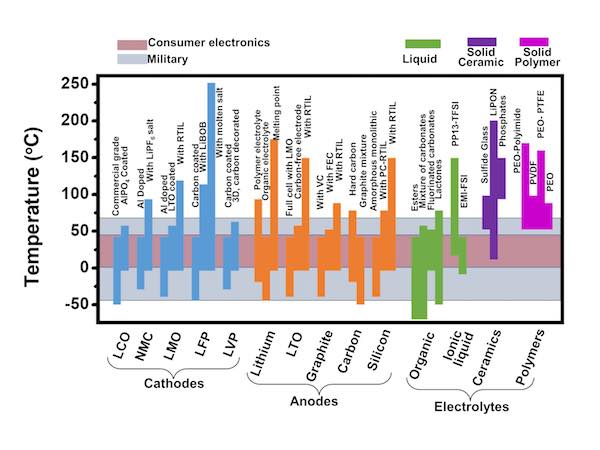
There has been a whole heck of a lot of research on lithium-ion batteries recently.
And with so much research—examining various types of batteries and diverse materials for battery cathodes, anodes, and electrolytes—it’s sometimes hard to make sense of it all.
Now, that might be a lot easier, thanks to Rice University researchers’ review of recent lithium-ion battery research.
The review stacks up lithium-ion cathode, anode, and electrolyte materials against one another, focusing on how batteries perform across a wide temperature range.
“We searched hard to find one paper that talks about all the problems at the same time and what all the individual components experience at extreme temperatures, and we couldn’t find one,” Hemtej Gullapalli, a postdoctoral researcher at Rice and co-author of the paper, says in a Rice press release. “So we believe this is a good opportunity to survey the field.”
In addition to reviewing organic and ionic liquid electrolytes for lithium-ions, the review also stacks up solid polymer and solid ceramic electrolytes as well, both of which offer performance at elevated temperature ranges—which may soon be necessary considering the world’s rising temperatures.
Solid ceramic electrolytes enable a wider range of operating temperatures than solid polymer electrolytes, according the researchers’ map below, although liquid organic electrolytes have the advantage of lower operating temperatures.

A map created by materials scientists at Rice University will help labs develop lithium-ion batteries for extreme environments. Credit: Ajayan Group; Rice University
“Most research involving batteries and temperatures involve management systems: For instance, if a phone is used in cold temperatures, they slow it down a little bit to preserve the battery,” Gullapalli explains in the release. “But we found in our review that the perspective is changing slightly. To make batteries that work from low to high temperatures, scientists have to take the materials perspective to see what temperature is specifically doing to the materials.”
Altogether, by comparing energy densities and temperature ranges for battery components of various materials, the review provides a comprehensive view of material pros and cons to guide future battery research and development.
“Building an ideal or a close-to-ideal system requires a thorough understanding of the subtle mechanisms and replacing each delinquent component with a suitable alternative,” Pulickel Ajayan, Rice materials scientist and senior author of the new paper, says in the release. “A trivial component at ambient conditions can change the whole electrochemistry when exposed to high temperatures.”
“We compared stabilities of materials with respect to each other and against a temperature scale,” Ajayan adds in the release. “This will help researchers cherry-pick a required combination for their needs.”
The review, published in Nature Energy, is “A materials perspective on Li-ion batteries at extreme temperatures” (DOI: 10.1038/nenergy.2017.108).
